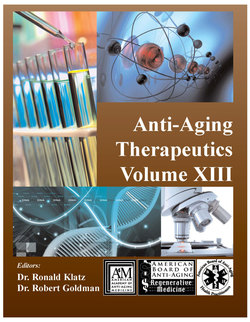Читать книгу Anti-Aging Therapeutics Volume XIII - A4M American Academy - Страница 42
На сайте Литреса книга снята с продажи.
INTRODUCTION
ОглавлениеResveratrol (trihydroxystilbene), a phytoalexin from red wine, has become a popular anti-aging supplement and the focus of escalating research efforts in recent years. Phytoalexins are naturally occurring compounds synthesized by plants as part of their defense against environmental challenges, such as microbial infection. Because of this, they possess antibiotic and antioxidant properties, and in the case of resveratrol, a long list of other potentially useful capabilities. These have been reported to include activation of sirtuins, the enzymes that mediate the metabolic shift that produces the increase in lifespan from caloric restriction. Resveratrol’s pleiotropic properties place it as a contender for a comprehensive anti-aging compound.
In order to consider the possibility of a “true” anti-aging intervention, a definition is needed. Though there are various ways to define anti-aging, for purposes of this discussion a comprehensive approach is taken, to include the following:
•Maintenance and restoration of youthful appearance
•Slowing of age-related cellular processes leading to reduced rates of degenerative diseases
•Lifespan extension
•Bioavailability
A Medline database search returns more than 3500 citations for resveratrol, with annual listings increasing exponentially. In 1991 there were only two articles in the biomedical literature on resveratrol, whereas there were approximately two each day in 2010, reflecting increasing interest on several fronts. However, only a few articles are based on clinical trials in human subjects, so if resveratrol is to be clinically useful a systematic approach is required.
Given that red wine is the primary source or resveratrol in the diet, the theory has been advanced that resveratrol provides the benefit attributed to regular wine consumption, a phenomenon characterized by a “J-shaped curve” of relative risk vs. disease incidence (moderate-consumption has a lower relative risk than non-consumption, high-consumption has a steeply rising risk.) The numerous other anti-aging benefits of red wine consumption also hold a potential relationship to resveratrol, so epidemiologic studies on red wine and health may serve as a useful starting point.
Once a clear relationship between wine consumption and a specific anti-aging benefit emerges, the next step is to formulate a plausible cause-effect explanation. Several lines of research support the role of resveratrol in specific mechanisms believed to be involved in wine’s healthful benefits, so experimental evidence for the proposed cause-effect relationship is also necessary. Ideally, this would culminate in clinical trial data leading to level I evidence as required for evidence-based practice. Recent publications have cast doubt on whether resveratrol functions at a biochemical level as previously reported, so clinical trial data is especially important.
Figure 1. Typical J-shaped curve
